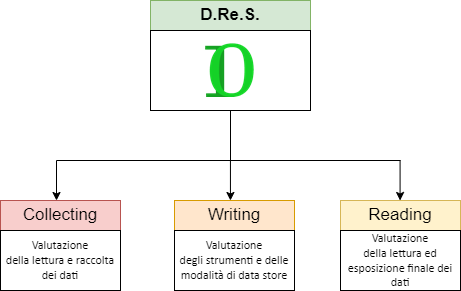D.Re.S. was born as a tool for assessing the reliability of the computer data collected, stored and exposed to the end user by a software system, be it a proprietary program or website. D.Re.S. it is therefore applicable to any IT reality thanks to its enormous versatility and transferability.
Designed at the beginning of 2021, it identifies through the address https://dres-project.org (and through the equivalent domain name https://dresproject.org ) the official publication and update channel, as well as the public collection of the guidelines necessary for the application of the model to a product software. Obviously, since this is a standard not officially recognized (we are still talking about an experimental thesis project), it does not have any type of internationally recognized name or definition. All the material related to it is contained in this document and within the web pages referring to the publication address.
The first version of D.Re.S. was released on September 27, 2021. To date, 2 minor upgrades have been made with respect to the standard initially defined, thus certifying the current version to release 1.2 (always verifiable online).
This standard mainly consists of 3 macro-sections, called Evaluation Sections which are called
- Data reading and collecting
- Data store
- Data reading and presentation

Each of these sections is made up of a series of Evaluation Points , that is characteristic focal points of the life phase of the computer data which, depending on their implementation, influence the reliability of the entire evaluation portion and consequently the D.Re.S. Final score. These Points have the purpose of going into the detail of the section in question and highlighting its criticalities or, vice versa, underlining its strengths.
The Evaluation Points have different “weights” as the D.Re.S. Score provides a weighted evaluation based on the impact on the reliability of the IT data of the entire structure of the single evaluation element. Consequently, a single Point can feature from 1 to 5% of the entire section evaluation. This degree of strength of a data lifecycle property has been accurately established and not at all random. The studies applied on real examples of software and web products have made it possible to calibrate these thresholds on the basis of the robustness and reliability of the data presented by them, consequently expanding the generalization of the D.Re.S. model. and its universal applicability.
As with the Evaluation Points , the Evaluation Sections also have a different specific weight. In this case, however, the situation is much more balanced and you can see a gradually decreasing concentration of points starting from the collection activity up to the presentation of the data.
The reading and data collection phase is therefore decisive both due to the complex work of verification and integration of systems capable of collecting the data from the external environment and representing it in digital format, and due to the fact that the saving of a computer data untrue inevitably influences the whole chain of subsequent steps in its entirety. Data collected incorrectly, if not accurately identified and discarded or corrected, almost certainly leads to an incorrect final representation of the information requested.
The same can be deduced for the data saving phase. A badly configured or even worse corrupt data store almost completely cancels the possibility of providing the user with correct data. Therefore, the data storage and conservation phase is crucial for the entire life cycle of digital information, but it is strongly influenced by a data collection activity which, if not carried out in a workmanlike manner, invalidates the rigidity and dedicated attention for this step.
Another focal point for determining the reliability of IT data is given by the communication channels, to be distinguished into input channels, used for the passage of information from the collection tools to the storage site, and output channels, responsible for the passage data from the storage medium to the user communication interface. This is often a decisive point for the calculation of the D.Re.S. Score and consequently it is inevitable that it covers a large part of the score available for the sections involved.
